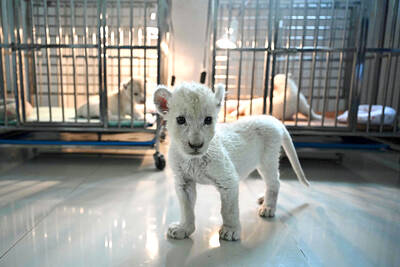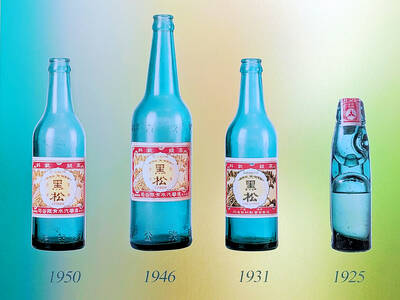Three o’clock — Blake: Noah’s going to be pissed off.
We finally found a day when we both have free time for the “Taipei gallery crawl” we’ve been talking about for months and planned to meet at noon. I jump out of bed and call Noah. He doesn’t answer. Maybe he’ll just do the article without me. I run to the bathroom, stick my head under the faucet and run back to answer my ringing phone.
“Sorry, I just woke up. I’ll be there in 20 minutes,” I say while pulling on a sock.
Noah is not amused.
I look at my window. It’s pitch dark, 3am.
Nine hours later:
I’m sipping a vodka milk tea outside Eslite Bookstore’s Dunhua Branch (台北敦南誠品) and studying a gem of a pamphlet: Gallery Guide No. 8, published by the Art Galleries Association R.O.C. (AGA). The poster-sized fold-out has maps to art spaces in Taipei, Taichung, Tainan, Kaohsiung, Hsinchu and Chiayi cities, as well as a few in Taoyuan, Miaoli and Taichung counties.
AGA director Joanne Chen (陳韋晴) says the guide is available at more than 175 locations nationwide including galleries, MRT stations and Eslite bookstores.
When Noah arrives, we have a quick lunch at a BYOB coffeeshop and plan our route. He has an appointment at 4pm and isn’t drinking — the gall — so we decide to limit ourselves to quick stops at four or five galleries.
Finding them won’t be hard.
“Four new galleries have opened in the last six months,” Chen says. “There are more than 100 galleries in Taipei City; 75 percent of them are contemporary and most of them are in or around Da-an District.”
According to the map, there are more than 30 galleries
within walking distance. Most have shows that don’t see many
non-collector visitors after their openings, so the staffers are usually happy to give short tours and explain what the artists are trying to do.
After a quick stop at a convenience store for another “electric milk tea,” we’re off.
Lin & Lin — Noah:
Around the corner from Eslite is Lin & Lin Gallery (大未來林舍畫廊). Established 17 years ago, the gallery began as a partnership between Tina Keng (耿桂英) and Tim Lin (林天民). After Keng struck out on her own last summer with Tina Keng Gallery (大未來耿畫廊), Lin’s son, David Lin (林岱蔚), took over as manager of Lin & Lin.
Over cups of “old man’s tea” (老人茶) — no relation to Blake’s concoction but refreshing nonetheless — the elder Lin discussed his changing focus on art, one that parallels changes in Taiwan’s market over the past two decades.
Lin said that after making a small fortune selling Western and European modern art to Japanese clients in the late 1980s and early 1990s, he returned to Taiwan and opened up Lin & Keng Gallery to promote Chinese modern and contemporary art.
“At that time there wasn’t much of a market for Chinese art,” he said. “You could buy a Zao Wou-ki (趙無極) [painting] at auction for US$10,000.” A Zao painting fetched NT$63.2 million (US$1.98 million) at a December auction last year.
As prices of Chinese modern and contemporary art began to balloon in the late 1990s, Lin said he became “concerned about local artists.”
“How do we develop these artists when everyone is focused on high-priced [Chinese] art? So we began to promote young [Taiwanese] contemporary artists,” he said.
If the current exhibit, Taiwan Art Rise, is anything to go by, that’s exactly what the gallery did. The group show features a who’s who of Taiwan’s top contemporary artists, including works by Chen Chieh-jen (陳界仁), Wu Tien-chang (吳天章) and Kuo Wei-kuo (郭維國).
And business is good. Two weeks after the exhibit opened,
75 percent of the works on display were already sold. The
gallery also plans to move to new, much larger, digs in June
(16 Dongfeng St, Taipei City, 台北市東豐街16號).
“We want to promote many Taiwanese artists but right now with such a small space, we can only show one work by each artist in a group exhibit,” David Lin said.
We still have more galleries to view, so we pack up and get ready to leave. Besides, Blake looks as though he’s itching for another swig of his tea. Before heading out into the balmy Taipei afternoon, the elder Lin tells us he will continue to promote high-caliber Taiwanese artists working in video, painting and sculpture while his son David uses his background in fine art and industrial design to promote a new generation of Taiwanese artists.
Chi-Wen Gallery — Blake:
Noah is taking this much too seriously. Two-handed namecard exchanges, leaves in hot water called “old man’s tea,” in-depth questions: It’s all fun and good, but we’re well behind schedule.
Less than a block from Lin & Lin’s current location is Chi-Wen Gallery (其玟畫廊), established in 2004 as Taipei Moma (hat tipped to the Museum of Modern Art in New York) and slightly hidden on the third floor above a wine and cigar bar called Habano 19.
Joanne C.W. Huang (黃其玟) opened the small space after working for six years at Hanart (漢雅軒), one of the largest galleries in Taiwan until it closed its doors here in 2003. The art market lulled around that time and Hanart, which focused on Chinese and Taiwanese painters and sculptors, is now based in Hong Kong.
Huang studied painting at university and dabbled in travel writing before working at Hanart, and when it closed she decided to open her own gallery.
About two years later she decided “Moma” was a silly name for a gallery the size of a 7-Eleven and switched to “Chi-Wen.”
Huang specializes in Taiwanese new media art and photography, but doesn’t split hairs.
“Some artists, even if they’re video artists, they also do paintings,” she says. “They use other media too.”
The current show is a solo exhibition of paintings by Taiwanese artist Kuo Hung-kun (郭弘坤), and the next is Huang’s first collaboration with a Chinese art space. The opening for Ying Yefu (嬰野賦), a Xian-based artist represented by Shanghai’s Art Labor Gallery who uses a traditional Chinese ink-painting style to depict surrealist images of four-eyed babies and girls doing strange things with their ponytails, will be held on May 8 at 3pm.
Most importantly: Will there be booze?
“Of course. Wine, beer, everything,” Huang says.
So why are we supping leaves in hot water again?
NOAH: Because not everyone wants to be slurring their words at an afternoon interview, and I have another one in half an hour. Never mind, with more than 100 galleries left on the AGA hit list, there will be plenty of opportunities to go on another gallery crawl in the future.
This is the first article in an occasional series.

Behind a car repair business on a nondescript Thai street are the cherished pets of a rising TikTok animal influencer: two lions and a 200-kilogram lion-tiger hybrid called “Big George.” Lion ownership is legal in Thailand, and Tharnuwarht Plengkemratch is an enthusiastic advocate, posting updates on his feline companions to nearly three million followers. “They’re playful and affectionate, just like dogs or cats,” he said from inside their cage complex at his home in the northern city of Chiang Mai. Thailand’s captive lion population has exploded in recent years, with nearly 500 registered in zoos, breeding farms, petting cafes and homes. Experts warn the

No one saw it coming. Everyone — including the Chinese Nationalist Party (KMT) — expected at least some of the recall campaigns against 24 of its lawmakers and Hsinchu Mayor Ann Kao (高虹安) to succeed. Underground gamblers reportedly expected between five and eight lawmakers to lose their jobs. All of this analysis made sense, but contained a fatal flaw. The record of the recall campaigns, the collapse of the KMT-led recalls, and polling data all pointed to enthusiastic high turnout in support of the recall campaigns, and that those against the recalls were unenthusiastic and far less likely to vote. That

The unexpected collapse of the recall campaigns is being viewed through many lenses, most of them skewed and self-absorbed. The international media unsurprisingly focuses on what they perceive as the message that Taiwanese voters were sending in the failure of the mass recall, especially to China, the US and to friendly Western nations. This made some sense prior to early last month. One of the main arguments used by recall campaigners for recalling Chinese Nationalist Party (KMT) lawmakers was that they were too pro-China, and by extension not to be trusted with defending the nation. Also by extension, that argument could be

Aug. 4 to Aug. 10 When Coca-Cola finally pushed its way into Taiwan’s market in 1968, it allegedly vowed to wipe out its major domestic rival Hey Song within five years. But Hey Song, which began as a manual operation in a family cow shed in 1925, had proven its resilience, surviving numerous setbacks — including the loss of autonomy and nearly all its assets due to the Japanese colonial government’s wartime economic policy. By the 1960s, Hey Song had risen to the top of Taiwan’s beverage industry. This success was driven not only by president Chang Wen-chi’s